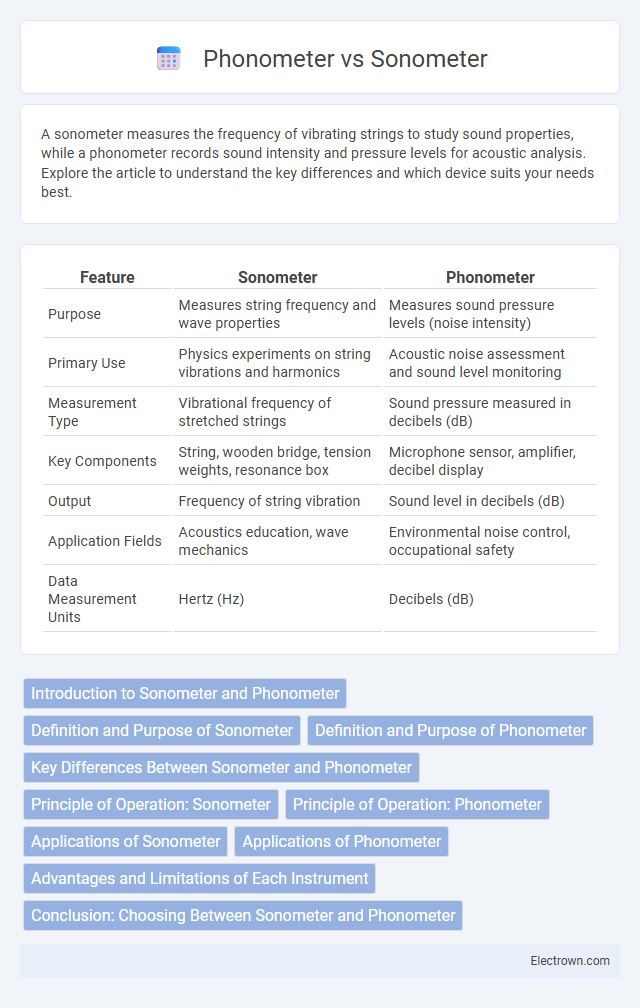A sonometer measures the frequency of vibrating strings to study sound properties, while a phonometer records sound intensity and pressure levels for acoustic analysis. Explore the article to understand the key differences and which device suits your needs best.
Table of Comparison
| Feature | Sonometer | Phonometer |
|---|---|---|
| Purpose | Measures string frequency and wave properties | Measures sound pressure levels (noise intensity) |
| Primary Use | Physics experiments on string vibrations and harmonics | Acoustic noise assessment and sound level monitoring |
| Measurement Type | Vibrational frequency of stretched strings | Sound pressure measured in decibels (dB) |
| Key Components | String, wooden bridge, tension weights, resonance box | Microphone sensor, amplifier, decibel display |
| Output | Frequency of string vibration | Sound level in decibels (dB) |
| Application Fields | Acoustics education, wave mechanics | Environmental noise control, occupational safety |
| Data Measurement Units | Hertz (Hz) | Decibels (dB) |
Introduction to Sonometer and Phonometer
A sonometer is a device used to study the relationship between string tension, length, and frequency of sound produced by vibrating strings, essential in acoustics and physics experiments. A phonometer, on the other hand, measures the intensity or loudness of sound waves in decibels, commonly used in noise pollution assessments and audio engineering. Both instruments serve key roles in sound analysis but focus on different acoustic properties--frequency versus sound intensity.
Definition and Purpose of Sonometer
A sonometer is a scientific instrument used to study the relationship between tension, length, and frequency of a vibrating string, primarily in acoustics and physics experiments. Unlike a phonometer, which measures sound intensity or volume, the sonometer is designed to analyze string vibrations and their properties, helping researchers understand wave mechanics and musical pitch. Your use of a sonometer can enhance precision in experiments related to sound production and harmonic frequencies.
Definition and Purpose of Phonometer
A phonometer is an acoustic measuring instrument designed to quantify sound intensity or pitch, often used in voice analysis and environmental noise assessment. Unlike a sonometer, which measures string tension and frequency vibrations in musical instruments, the phonometer captures decibel levels to evaluate auditory environments or vocal characteristics. Its primary purpose is to provide precise sound measurements for applications in acoustics, audio engineering, and medical diagnostics.
Key Differences Between Sonometer and Phonometer
The Sonometer measures the frequency of sound waves by analyzing the vibrations of a stretched string under tension, primarily used in acoustic experiments to study wave properties. The Phonometer, on the other hand, quantifies sound intensity and loudness using a microphone coupled with electronic circuits, often employed in noise pollution assessments and audio calibration. Key differences lie in their measurement focus: Sonometer evaluates wave characteristics like frequency and wavelength, whereas Phonometer focuses on sound pressure levels and amplitude.
Principle of Operation: Sonometer
The sonometer operates on the principle of vibrating strings, where tension, length, and mass per unit length determine the pitch produced. By adjusting the tension or length of the string fixed at both ends, the frequency of vibration changes, allowing precise measurement of sound waves and frequencies. Your understanding of harmonic oscillations is crucial when using a sonometer to study wave properties in physics experiments.
Principle of Operation: Phonometer
Phonometers operate on the principle of measuring sound pressure levels using a sensitive microphone or sensor that converts acoustic energy into an electrical signal, quantifying the loudness of sound in decibels (dB). This device captures fluctuating air pressure caused by sound waves and provides accurate readings critical for acoustic analysis. Your understanding of noise pollution or audio quality can greatly benefit from the precise data a phonometer offers through its sound pressure measurement capabilities.
Applications of Sonometer
Sonometers are primarily applied in physics education and research for studying the relationship between tension, length, and frequency of vibrating strings, facilitating experiments on wave properties and harmonic frequencies. They serve as essential instruments in acoustics laboratories for analyzing sound waves and validating principles of string vibration and resonance. Industries use sonometers to calibrate musical instruments and ensure precise tuning by measuring string tension and vibration characteristics.
Applications of Phonometer
Phonometers are primarily used in medical audiology to measure sound intensity and evaluate hearing loss by quantifying decibel levels during hearing tests. They play a critical role in occupational health to monitor noise exposure in workplaces, ensuring compliance with safety standards. Unlike sonometers, which are typically used for general sound level measurement, phonometers are specialized for precise auditory diagnostics and therapeutic settings.
Advantages and Limitations of Each Instrument
Sonometers provide precise frequency measurement by adjusting the string tension and length, making them ideal for acoustic experiments, but they are limited by manual calibration and less suitability for complex sound analysis. Phonometers excel in measuring sound intensity levels accurately with digital displays and ease of data logging, though they can be affected by background noise and require calibration for different environments. Your choice depends on whether frequency precision or sound intensity analysis is the priority for your application.
Conclusion: Choosing Between Sonometer and Phonometer
Choosing between a sonometer and a phonometer depends on your specific measurement needs: a sonometer is ideal for measuring string tension and frequency in musical instruments, while a phonometer excels in assessing sound intensity and loudness levels. Your choice should reflect whether you prioritize precise vibrational properties or comprehensive acoustic analysis. Understanding these core differences ensures optimal tool selection for accurate and relevant sound measurements.
Sonometer vs Phonometer Infographic

 electrown.com
electrown.com